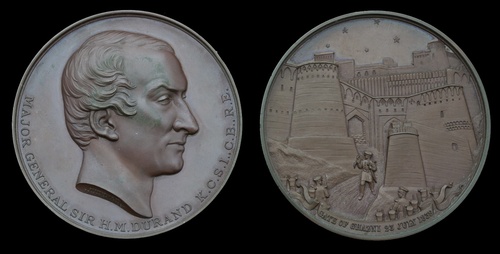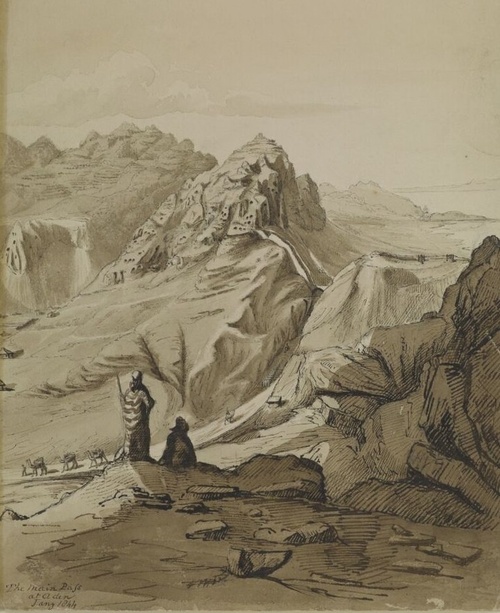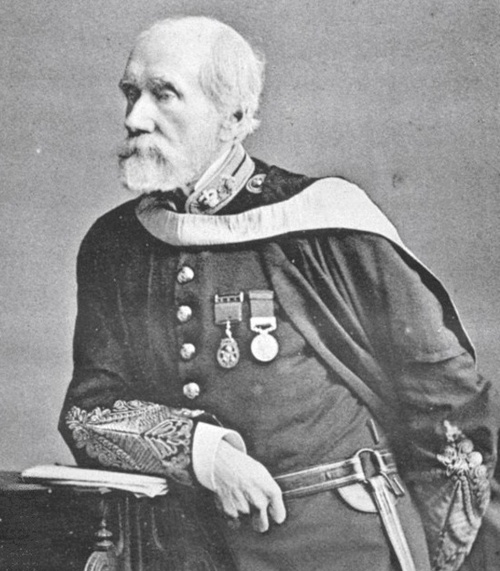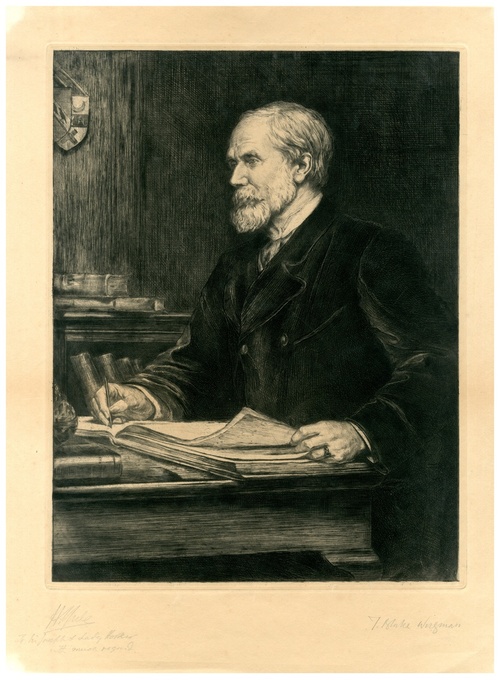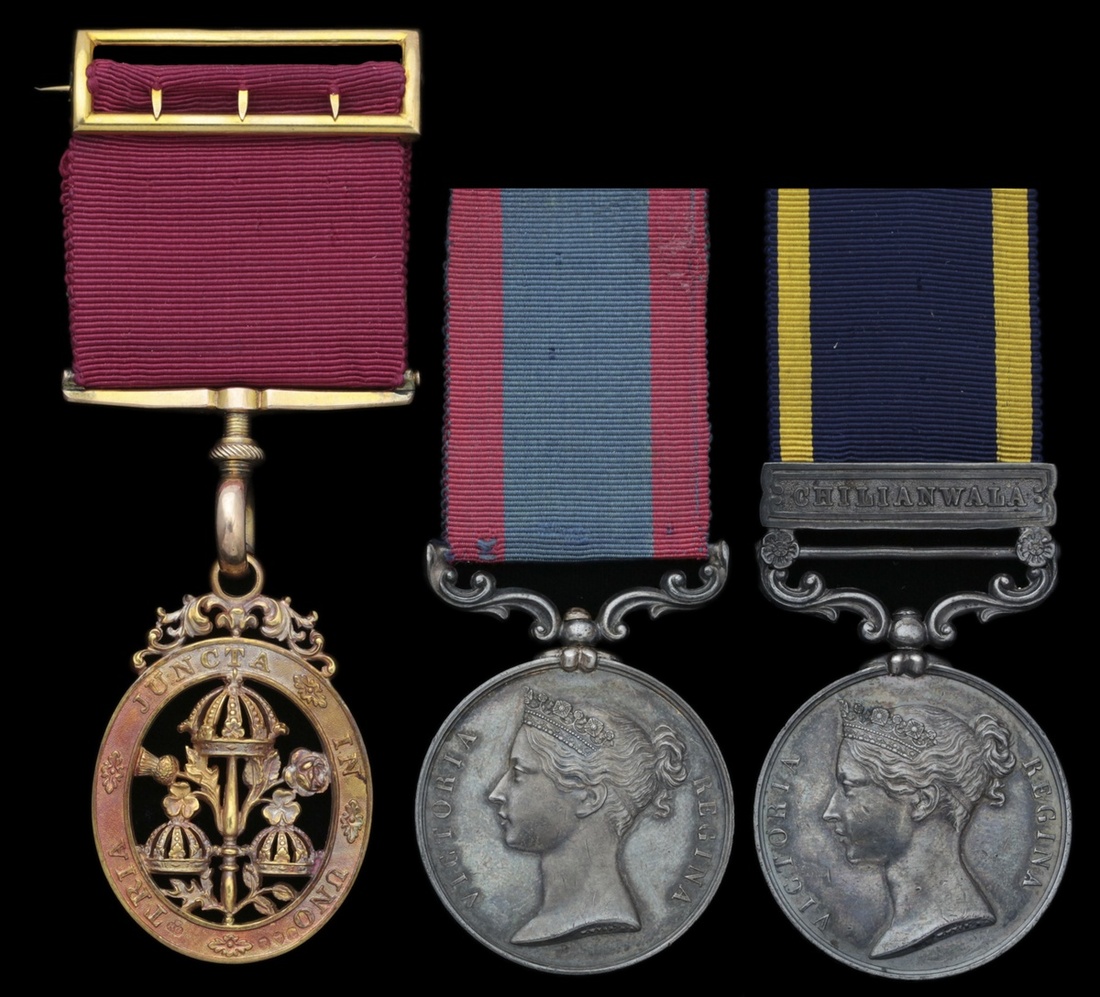Auction: 22002 - Orders, Decorations and Medals
Lot: 52
Sold by Order of a Direct Descendant
The C.B. and Royal Engineers Durand Medal group of five awarded to Colonel Sir H. Yule, K.C.S.I., C.B., Royal Engineers, the famous Scottish orientalist and author of many works including the Hobson-Jobson Dictionary
The Most Honourable Order of the Bath, Civil Division, Companion's Badge, gold (18 carat), by Robert Garrard, hallmarks for London 1860, with gold riband buckle; Sutlej 1845-46, no clasp (Lieut. H: Yule Engineers); Punjab 1848-49, 1 clasp, Chilianwala (Lieut. H. Yule. Engineers.); Royal Engineers Institute Durand Medals, obverse: bust of Major General Sir H. M. Durand, K.C.S.I., C.B., R.E.; reverse: the towers and walls of the fort at Ghuznee, in their damaged fitted and embossed case of issue, good very fine (5)
Perhaps the best biography of Henry Yule is offered by Coutts Trotter in Dictionary of National Biography, 1885-1900, Volume 63:
'Geographer, born 1 May 1830 at Inveresk, near Edinburgh, was youngest son of Major William Yule (1761-1839) of the East India Company's service and of his wife Eliza, daughter of Paterson of Braehead in Ayrshire. The family was settled for several generations as tenant-farmers at Dirleton in East Lothian. The name is Scandinavian. Major Yule, Sir Henry's father, was versed in oriental literature. He retired from India in 1806 with a valuable collection of Persian and Arabic MSS. which was presented by his sons to the British Museum. He issued privately in 1832 a lithographed edition of the Apothegms of Ali, the son of Abu Talib in the Arabic with an old Persian version and an English translation by himself.
Henry Yule was educated at the High School in Edinburgh, and was afterwards a pupil, first with Henry Parr Hamilton, and then with James Challis, subsequently Plumian professor at Cambridge. His fellow pupils included John Mason Neale and Harvey Goodwin the mathematician, afterwards bishop of Carlisle, who has described Yule's intellectual development as extraordinary for his years. He had, the bishop adds, 'considerable geometrical ingenuity,' but 'showed much more liking for Greek plays and for German than for mathematics.'
Having acquired a competent acquaintance with the classics, he went to Addiscombe in 1837, and, passing-out head of the college in 1839, went for a year to Chatham. In 1840 he was appointed to the Bengal Engineers. His first appointment in India was among the Kásias, a primitive Mongoloid people on the north-east border of Bengal, who greatly interested him, and his account of their quaint manners and customs, of the character of the country and of its megalithic monuments, showed the best of his studies.
In 1843 he came home on leave to marry his cousin Anna Maria (d. 1875), daughter of General Martin White of the Bengal Army. From 1843 to 1849 he served with a group of officers, who all afterwards attained distinction (among then Napier, Durand, Baird, Smith, Cautley, W. E. Baker, W. W. Greathed, and R. Strachey), in the restoration and development of the irrigation system of the Moguls in the North-West Provinces. His labours were interrupted by the Sikh Wars of 1845-6 and 1848-9, in both of which he took part. He was at home on furlough from 1849 to 1851 and during that period lectured at the Scottish Military Academy. While thus engaged, he wrote a volume on Fortification. Professionally it may still be read with profit, while its interesting biographical notices and portraits of famous engineers completely differentiate it from the ordinary technical treatises. A French translation appeared in Paris in 1859. His warm regard for Henry Dundas Trotter, then recently returned from his expedition to the Niger, led Yule to take an interest in the slave-trade controversy, and his able pamphlet, The African Squadron Vindicated (London, 1850), passed through more than one edition.
Having early gained the confidence and regard of Lord Dalhousie, the Governor-General of India, he was in 1855 appointed Under-Secretary to the newly formed Public Works Department. Besides irrigation, this Department was entrusted with the direction of the great scheme for railways which Lord Dalhousie was urging forward. The railway scheme entailed from its novelty much labour and anxiety. From this work Yule was temporarily detached as Secretary to Colonel (afterwards Sir Arthur) Phayre's friendly embassy to Burmah, and to act as its chronicler. His report to government, afterwards recast, and published in 1858 as A Narrative of the Mission to Ava in 1855, was his first publication to attract wide attention. It is mainly illustrated by his own pencil.
The confidence in Yule shown by Lord Dalhousie was continued to him in very full measure by the succeeding Governor-General, Lord Canning. Yule retired from the service in 1863, partly on account of his wife's health and was created C.B. in the following year.
He went on to investigate the histories of old Italian missionaries and travellers in Central Asia, he took up his residence at Palermo. In 1863 he brought out for the Hakluyt Society Mirabilia descripta. The Wonders of the East by Jordanus, and in 1866 Cathay, and the Way thither (2 vols.), containing, besides biographical notices of old travellers and many of their curious letters and reports, a fund of information on medieval Asia, with a full and well-digested accounts of the intercourse from early times between China and the west.
Yule's famous editions of Marco Polo appeared in 1871 and earned him the Gold Medal of the Geographical Society of Italy, and later the Founder's Medal of the Royal Geographical Society. The book is a storehouse of curious and profound research, and placed the editor by common consensus in the first rank of geographers. A remarkable feature in Yule's work is the skill with which he unravels the most confused narratives of uncritical and credulous medieval writers, and the satisfaction he feels in rehabilitating, when possible, their character for accuracy. An enlarged edition appeared in 1875. A new edition of Yule's Marco Polo is now (1900) in preparation by Professor Cordier of Paris. Yule returned to England after his first wife's death in 1875, and was placed on the Indian Council, from which he retired shortly before his death in 1889.
His presence there was much valued, not only for his literary services, but from his habit of viewing all questions on their own merits, rather than by the light of expediency or of procedures.
He married secondly, in 1877, Mary Wilhelmina (d. 26 April 1881), second daughter of Fulwar Skipwith of the Bengal Civil Service, but she died four years afterwards. At this time his own health was beginning to break, but his record of work hardly diminished. Two important works date from these years, Hobson-Jobson, a Glossary of Anglo-Indian Colloquial Words and Phrases (1886), the terms dealt with being culled not only from books but from diaries and East India Company's court letters of the seventeenth and eighteenth centuries, and copiously illustrated by a quaint medley of research collected during his miscellaneous reading, and stored till wanted in his unfailing memory. It is dedicated in graceful Latin to his brother. Sir George. His last work for the Hakluyt Society was the Diary of Sir William Hedges (1887), full of curious details of the inner working of the old and new East India companies, comprising incidentally the strange history of Governor Pitt, of Pitt diamond celebrity. The Encyclopedia Britannica also contains many important geographical and biographical papers, and the various geographical journals for many years had valuable articles from his pen. For a new edition of John Wood's Journey to the Oxus (1872), Yule wrote an introduction which is a brilliant essay on the topography of the Upper Oxus regions, with, incidentally, an exposure-a remarkable piece of geographical intuition-of the curious literary frauds of the great Russian geographer Klaproth. Yule also contributed introductions to Nikolai Mikhailovitch Przheval'sky's Mongolia (1876), and for Captain William John Gill's River of Golden Sand (1880) he prepared a learned and highly interesting study of the river systems of Eastern Tibet and Burmah. A long series of biographical notices, chiefly in the Royal Engineers' Journal, of distinguished engineers, are models of what such compositions ought to be. He gave, besides, a vast amount of friendly help, in suggestions and criticism, to the works of others, and notably to writers for the Hakluyt Society, of which he was president until the end of 1899.
The widely awakened interest of late years in the geography as well as in the medieval history and archaeology of Central Asia is largely due to Yule's labours. His erudition and sympathy have inspired alike explorer and student. Baron F. von Richthofen, a scientific traveller and geographer of the first rank, and endowed with wide philosophic observation, speaks of Yule's unique position as an historical geographer, and attributes to his mode of treating his subject (viz. by combining 'wissenschaftliche Grundichkeit mit anmutender Form') a wide influence, not only on English but on continental scholars.
He was a many-sided man. His efforts in verse, serious and humorous and sometimes in good Scots, were very happy, and he was interested to the last in art, politics, discovery, and social and philanthropic movements. A keen and delightful sense of humour was never far from the surface in his conversation or in his writings.
He received the honorary degree of LL.D. from Edinburgh in 1884, and was created K.C.S.I. in 1889. He died at his residence in London on 30 December 1889, having within eight hours of his death dictated in Latin the following message to the Institute of France, which had just made him a corresponding member; 'Reddo gratias, illustrissimi domini, ob honores tanto nimios quanto immeritos. Mihi robora deficiunt, vita collabitur, accipiatis voluntatem pro facto. Cum corde pleno et gratissimo moriturus vos, illustrissimi domini, saluto. Yule.'
His portrait, painted by Mr. T. B. Wirgman, is in the Royal Engineers' Mess-house at Chatham.'
Sold together with an original plate impression from the origian pen and ink drawing of the recipient, by Theodore Blake Wirgman, signed in pencil by both the artist and sitter, dedicated to 'Sir Joseph (Sir Joseph Dalton Hooker OM GCSI CB PRS) & Lady Hooker, with much regard'.
Subject to 20% VAT on Buyer’s Premium. For more information please view Terms and Conditions for Buyers.
Sold for
£11,000
Starting price
£1800


